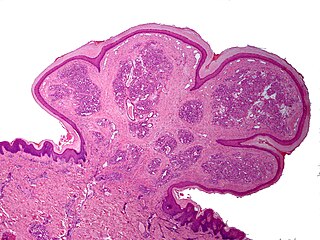Related Research Articles

Bartonella henselae, formerly Rochalimæa, is a proteobacterium that is the causative agent of cat-scratch disease (bartonellosis).

Bartonella is a genus of Gram-negative bacteria. It is the only genus in the family Bartonellaceae. Facultative intracellular parasites, Bartonella species can infect healthy people, but are considered especially important as opportunistic pathogens. Bartonella species are transmitted by vectors such as ticks, fleas, sand flies, and mosquitoes. At least eight Bartonella species or subspecies are known to infect humans.
Bartonellosis is an infectious disease produced by bacteria of the genus Bartonella. Bartonella species cause diseases such as Carrión's disease, trench fever, cat-scratch disease, bacillary angiomatosis, peliosis hepatis, chronic bacteremia, endocarditis, chronic lymphadenopathy, and neurological disorders.

A pyogenic granuloma or lobular capillary hemangioma is a vascular tumor that occurs on both mucosa and skin, and appears as an overgrowth of tissue due to irritation, physical trauma, or hormonal factors. It is often found to involve the gums, skin, or nasal septum, and has also been found far from the head, such as in the thigh.

The Australian angelshark is a species of angelshark, family Squatinidae, found in the subtropical waters of southern Australia from Western Australia to New South Wales between latitudes 18°S and 41°S, at depths down to 255 m (840 ft). Its length is up to 1.52 m (5 ft). Reproduction is ovoviviparous, with up to 20 pups in a litter.
A rickettsiosis is a disease caused by intracellular bacteria.

Bartonella bacilliformis is a proteobacterium, Gram negative aerobic, pleomorphic, flagellated, motile, coccobacillary, 2–3 μm long, 0.2–0.5 μm wide, and a facultative intracellular bacterium.
Bartonella quintana, originally known as Rochalimaea quintana, and "Rickettsia quintana", is a bacterium transmitted by the human body louse that causes trench fever. This bacterial species caused outbreaks of trench fever affecting 1 million soldiers in Europe during World War I.
Rickettsia felis is a species of bacterium, the pathogen that causes cat-flea typhus in humans. In cats the disease is known as flea-borne spotted fever. Rickettsia felis also is regarded as the causative organism of many cases of illnesses generally classed as fevers of unknown origin in humans in Africa.

Cat-scratch disease (CSD) or felinosis is an infectious disease that most often results from a scratch or bite of a cat. Symptoms typically include a non-painful bump or blister at the site of injury and painful and swollen lymph nodes. People may feel tired, have a headache, or a fever. Symptoms typically begin within 3–14 days following infection.
Spilopsyllus cuniculi, the rabbit flea, is a species of flea in the family Pulicidae. It is an external parasite of rabbits and hares and is occasionally found on cats and dogs and also certain seabirds that nest in burrows. It can act as a vector for the virus that causes the rabbit disease myxomatosis.
Bartonella alsatica is a proteobacterium. Like other Bartonella species, it can cause disease in animals. It is small, aerobic, oxidase-negative, and Gram-negative. Its rod-like cells were localized within wild rabbit erythrocytes when first described. The type strain is IBS 382T. It is associated with cases of lymphadenitis and endocarditis.
Rickettsia heilongjiangensis is a species of gram negative Alphaproteobacteria, within the spotted fever group, being carried by ticks. It is pathogenic.
Rickettsia massiliae is a tick-borne pathogenic spotted fever group Rickettsia species.
Bartonella coopersplainsensis is a Gram-negative, non-motile bacteria from the genus of Bartonella which was isolated from the blood of a wild rat.
Bartonella queenslandensis is a Gram-negative bacteria from the genus of Bartonella which was isolated from the blood of rats from the genus of Melomys in Queensland in Australia.
Bartonella rattaustraliani is a bacterium from the genus of Bartonella which was isolated from the blood of rats from the genus of Melomys.
Bartonella rattimassiliensis is a bacterium from the genus of Bartonella which was isolated from the rat Rattus norvegicus.
"Candidatus Bartonella mayotimonensis" is a candidatus bacteria from the genus of Bartonella which can cause endocarditis in humans
"Candidatus Bartonella thailandensis" is a candidatus bacteria from the genus of Bartonella which was isolated in Thailand.
References
- ↑ UniProt
- ↑ "www.wildlifehealthaustralia.com" (PDF). Archived from the original (PDF) on 2014-05-24. Retrieved 2014-05-23.
- ↑ Saisongkorh, W; Rolain, J. M.; Suputtamongkol, Y; Raoult, D (2009). "Emerging Bartonella in humans and animals in Asia and Australia". Journal of the Medical Association of Thailand = Chotmaihet Thangphaet. 92 (5): 707–31. PMID 19459536.
- ↑ Taxonomy Browser